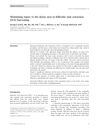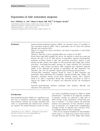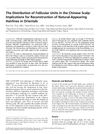TLDR A forehead-supporting chair improves comfort and results in hair transplant surgery.
The document discussed the benefits of a forehead-supporting chair system for follicular unit extraction (FUE) hair transplantation. It highlighted that while the seated position is commonly used due to better surgical field exposure and efficiency, traditional salon chairs lack head support, making it difficult for both the surgeon and patient during long procedures. A forehead support system was proposed to provide ergonomic benefits, such as maintaining scalp tension, reducing the gap between hair exit and internal angles, and minimizing graft torsion, which would ultimately reduce follicular injury and improve graft quality.
 13 citations
,
August 2016 in “Journal of Cosmetic Dermatology”
13 citations
,
August 2016 in “Journal of Cosmetic Dermatology” Using normal saline in vertical extraction for hair transplants reduces donor area injury more than acute extraction.
 11 citations
,
October 2015 in “Journal of Cosmetic Dermatology”
11 citations
,
October 2015 in “Journal of Cosmetic Dermatology” Half of hair restoration surgeons experience body discomfort, especially after follicular unit extraction procedures, and using ergonomic equipment or robotic devices could reduce this discomfort.
 45 citations
,
August 2013 in “Facial Plastic Surgery Clinics of North America”
45 citations
,
August 2013 in “Facial Plastic Surgery Clinics of North America” Using sharp tools and the right techniques in hair transplant surgery leads to less damage to hair follicles.
 October 2021 in “Indian Journal of Plastic Surgery”
October 2021 in “Indian Journal of Plastic Surgery” You can use hair from other parts of the body for scalp hair restoration.
2 citations
,
September 2017 Hair and scalp diseases can affect hair transplant success in Asians, and managing them is crucial.
 17 citations
,
June 2002 in “Dermatologic Surgery”
17 citations
,
June 2002 in “Dermatologic Surgery” Chinese patients have fewer hair follicles than Caucasians, and transplanting hair at 40% of normal density works for natural-looking hairlines.
 October 1987 in “Clinics in Dermatology”
October 1987 in “Clinics in Dermatology” Scalp reduction can improve hair distribution in certain baldness cases but requires careful patient selection and understanding of facial structure.






